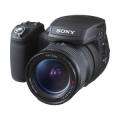Sony Cyber-shot DSC-R1 Announcement
Yesterday Sony announced a new digital camera: the Sony Cyber-shot DSC-R1. This is a very exciting camera for a number of reasons. Digital Photography Review has a preview of the camera available.
The most obvious thing that sets this camera apart from other semi-pro cameras is the sensor. It's a large APS-C sized sensor--more than 5× larger than the 2/3-inch sensor typically used in "prosumer" cameras. These large sensors have only been used in digital SLR cameras in the past. The exciting part about this is not that it's a 10 megapixel sensor, but the low noise levels that come with it. As I illustrated in Comparing a Prosumer Digital Camera and a Digital SLR, the noise level of the two differently-sized sensors is hardly even worth comparing. The larger sensor is just that much better. This means that higher ISOs with minimally objectionable noise are possible--in other words, you'll get better pictures in darker conditions!
The permanently-attached zoom lens has a great range of 14.3-71.5 mm, which--in 35 mm terms--is a 24-120 mm-equivalent lens. 24 mm is quite a bit wider than the 32-35 mm wide angle most cameras have. Almost 20 degrees difference in fact (a 24 mm lens has a ing.field of view of about 84 degrees, a 32 mm lens has a field of view of about 65 degrees). And on the long end, 120 mm is great for shooting just about anything.
The last feature that excites me quite a bit is the "Free Angle" LCD monitor. Yes, lots of other cameras have a rotating LCD monitor, and this one looks no different in that regard. Its placement--on top of the camera--is what I like. I can imagine that being able to use this as a waist-level finder could be very useful and convenient. This is different from other swivel LCD monitors in only one way: it's not sticking out. Using it as a waist-level finder and not having to think about it being snapped off is a good thing.
And yes, there are a few other interesting-sounding features I'd like to know more about: will the Raw mode write photos fast enough to be usable? The "Advanced Gradation Control System (AGCS)" is supposed to enhance dynamic range and minimize clipping--will it, and are there any drawbacks? The hot shoe is in a strange spot--how's the balance and usability with a flash attached? Having the viewfinder stick out so much is a good thing--no "nose compression!"

Share Your Thoughts (